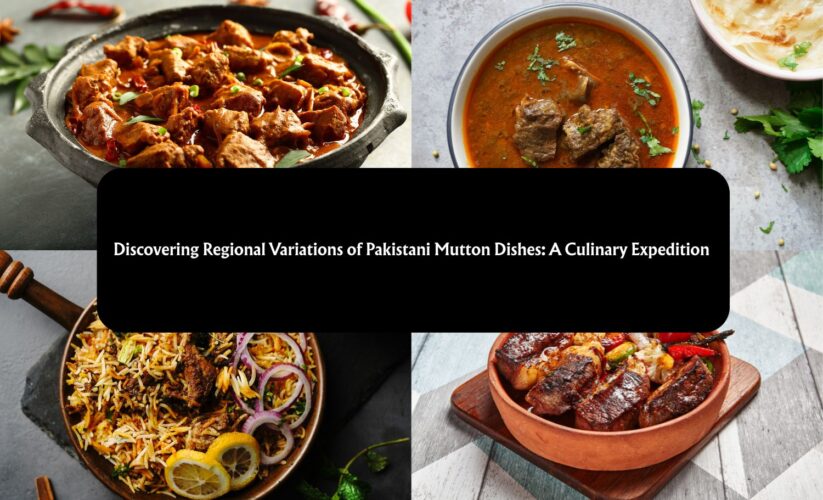
Discovering Regional Variations of Pakistani Mutton Dishes: A Culinary Expedition
Pakistan, a land of diverse landscapes and rich cultural heritage, offers a culinary tapestry woven with aromatic spices, hearty flavors, and time-honored traditions. Mutton, a beloved ingredient, takes center stage in many Pakistani dishes, each region showcasing its unique approach to preparing this succulent meat. This article embarks on a culinary expedition, exploring the regional variations of Pakistani mutton dishes at Chef Cooking Resort, unveiling the secrets behind their distinct flavors and the cultural significance they hold.
A Nation of Mutton Lovers: The Heart of Pakistani Cuisine
Mutton, known as “gosht” in Urdu, is a staple in Pakistani cuisine, particularly during celebrations, festivals, and family gatherings. Its rich flavor and versatility make it a favored ingredient in a wide range of dishes, from slow-cooked stews to grilled kebabs. The regional variations in mutton preparation reflect the unique climate, agricultural practices, and cultural influences of each area.
Punjab: Hearty and Robust Flavors
Punjab, the heartland of Pakistan, is famous for its rich and robust cuisine, featuring hearty mutton dishes that are both flavorful and satisfying.
- Mutton Karahi:
- A quintessential Punjabi dish, Mutton Karahi features tender mutton pieces cooked in a wok-like pan with tomatoes, ginger, garlic, and a blend of aromatic spices.
- Its rich, tomato-based gravy and tender mutton make it a favorite among locals and visitors alike.
- Mutton Kunna:
- A slow-cooked mutton stew, Kunna is cooked in a clay pot, allowing the flavors to meld beautifully.
- Its tender meat and flavorful gravy make it a comforting and satisfying meal.
- Mutton Pulao:
- A fragrant rice dish cooked with mutton, spices, and dried fruits, Mutton Pulao is a popular celebratory dish.
- Its aromatic spices and tender mutton make it a flavorful and festive treat.
- Nihari:
- A slow-cooked stew, traditionally cooked overnight. Locals make Nihari with mutton shanks, and a variety of spices. They eat it, which has a thick, rich gravy, with naan.
Sindh: Coastal and Desert Influences
Sindh, with its coastal areas and desert landscapes, offers a unique blend of mutton dishes. This thing reflects its diverse geography and cultural influences.
- Sindhi Biryani:
- A spicy and flavorful Biryani with potatoes, plums, and a generous amount of spices, Sindhi Biryani is a regional specialty.
- Its unique blend of spices and tender mutton make it a memorable dish.
- Mutton with Daal:
- A simple yet flavorful dish of mutton cooked with lentils and spices, Mutton with Daal is a common Sindhi meal.
- Mutton with Vegetables:
- Mutton cooked with a variety of seasonal vegetables, creating a nutritious and flavorful dish.
Khyber Pakhtunkhwa (KPK): Mountainous Flavors and Nomadic Traditions
KPK, with its mountainous terrain and nomadic traditions, offers hearty and flavorful mutton dishes that reflect the region’s unique climate and culture.
- Peshawari Karahi:
- A rich and flavorful mutton curry cooked with minimal tomatoes and a focus on aromatic spices, Peshawari Karahi is a regional specialty.
- Its tender mutton and intense flavors make it a favorite among meat lovers.
- Mutton Rosh:
- A simple yet flavorful dish of mutton cooked over hot stones, Mutton Rosh allows the natural flavors of the meat to shine.
- Its tender meat and smoky flavor make it a unique and memorable dish.
- Dumba Karahi:
- A Karahi made with Dumba (sheep) meat, a regional variation enjoyed in KPK.
Balochistan: Simplicity and Natural Flavors
Balochistan, with its arid climate and nomadic lifestyle, offers simple yet flavorful mutton dishes that emphasize the natural flavors of the meat.
- Sajji:
- Roasted lamb or mutton, Sajji is a Balochi specialty, cooked over an open fire.
- Its tender meat and smoky flavor make it a unique and delicious dish.
- Dampukht:
- Steamed meat, cooked with minimal spices to preserve the natural flavor of the meat.
The Art of Mutton Preparation: Time-Honored Techniques
Pakistani mutton dishes are often prepared using time-honored techniques that enhance the flavor and tenderness of the meat.
- Slow Cooking: Slow cooking is a common technique used to tenderize tough cuts of mutton and allow the flavors to meld beautifully.
- Marination: Marinating mutton in yogurt, spices, and herbs for several hours or even overnight enhances its flavor and tenderness.
- Use of Aromatic Spices: A blend of aromatic spices, such as cumin, coriander, cardamom, cinnamon, and cloves, is used to create the rich and complex flavors of Pakistani mutton dishes.
- Use of Ghee: Locals often use Ghee (clarified butter) in cooking mutton, adding richness and flavor.
Cultural Significance: Mutton as a Symbol of Celebration
Mutton plays a significant role in Pakistani celebrations and festivals, symbolizing prosperity and abundance.
- Eid ul-Adha: Mutton is the primary meat consumed during Eid ul-Adha, a festival commemorating Prophet Ibrahim’s willingness to sacrifice his son.
- Weddings: Mutton dishes are a staple at Pakistani weddings, symbolizing celebration and festivity.
- Family Gatherings: Mutton dishes are often prepared for family gatherings and special occasions, bringing people together around the table.
A Culinary Expedition:
Exploring the regional variations of Pakistani mutton dishes is a culinary expedition that will tantalize your taste buds and introduce you to a world of diverse flavors and traditions. From the hearty Karahis of Punjab to the smoky Rosh of Balochistan, each region offers a unique mutton experience that reflects its rich cultural heritage.
Additionally, read Chef Cooking Resort Blogs to explore the regional variations of Pakistani mutton dishes.





